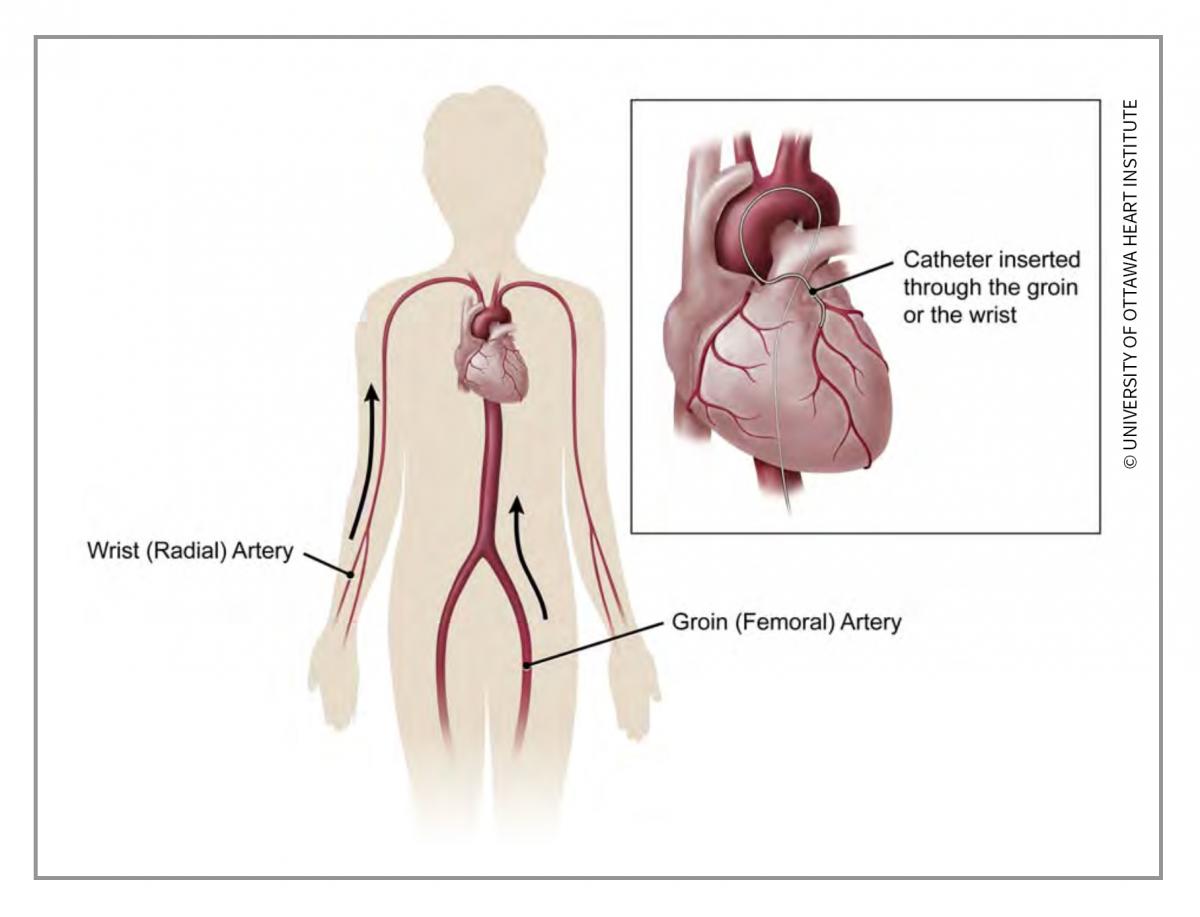Purpose
A coronary angiogram is a dye test used to detect heart problems. A long, thin flexible tube called a catheter is inserted into your wrist or your groin and guided up to your heart. Once in position, a dye is injected and X-ray pictures are taken. The special dye allows the X-rays to capture pictures of your coronary arteries and highlights where any blockages or narrowed spots may be. This test can also look at the condition of your heart valves and your heart muscle.

Although tests such as stress tests, echocardiograms, electrocardiograms, and physical examinations provide important information about your heart, they do not give all of the answers. In some cases, more information is necessary to make a correct diagnosis and decide the best treatment.
Coronary angiograms are conducted in the cardiac catheterization laboratories of the Heart Institute.
Description
Note: Please bring your Health Card and all of your medications in their original containers along with any vitamins or supplements that you take. Many of our patients also find it helpful to bring:
- A family member or friend to take notes or ask questions
- A list of your own questions to ensure that you have all the information
Before you have a coronary angiogram, expect to have:
- An assessment by a nurse that includes measuring your blood pressure and other vital signs
- A session to teach you about the procedure
- Review and signing of the consent form
- Blood tests and an electrocardiogram
- Specific instructions about your medications
- Cleaning and preparation of a small area of both groins or your wrist
Immediately before the procedure, you will be taken to the cardiac catheterization lab.
- You will be given medication to help you relax, but you will be awake during the procedure so that you can follow instructions from the doctor and nurses.
- The doctor will administer freezing to your groin or your wrist.
- A small catheter will be threaded through an artery in your wrist or groin and guided up to the heart.
- X-ray pictures will be taken and a special dye will be injected through the catheter to highlight your coronary arteries and identify if there are any narrowed sections or blockages.
- Most patients experience a sensation of body warmth as the dye is injected or the urge to empty their bladder.
- During the procedure, you may be asked to take a deep breath and hold it for a few seconds, or to cough.
- It is not unusual to experience some chest pain. Inform the nurse if you experience any discomfort or have concerns.
- The time for the procedure in the lab is usually 30 to 90 minutes.
After your procedure, you will be transferred back to the Day Unit.
- The nurse will frequently check your pulse, blood pressure, pulses in your feet or wrist, and the puncture site.
- You will be on bedrest for an hour if you had the catheter inserted in your wrist or up to six hours if the catheter was inserted in your groin. During this time, you may sleep or rest.
- If you experience discomfort, let the nurse know; you can be repositioned with help.
- If you are hungry, you will be given a snack.
- You will be encouraged to drink fluids to help flush the dye out of your kidneys. Ask your nurse for help if you need to go to the bathroom.
- The doctor will discuss the results of your coronary angiogram with you and make recommendations for any new treatments or medications at that time.
- Before you are discharged, you will be encouraged to walk around to ensure that you are feeling okay.
Patient instructions
If you are scheduled and waiting for a cardiac catheterization and you have questions or concerns, contact the Regional Cardiac Care Coordinator at 613-696-7061.
Please make arrangements for transportation home on discharge. You are not allowed to drive yourself. Discharge will take place approximately five to six hours after your procedure.
If you live a considerable distance from the Heart Institute, check with the doctor to see if you should stay close to the hospital the night of discharge. Arrangements for accommodations should be made in advance.

